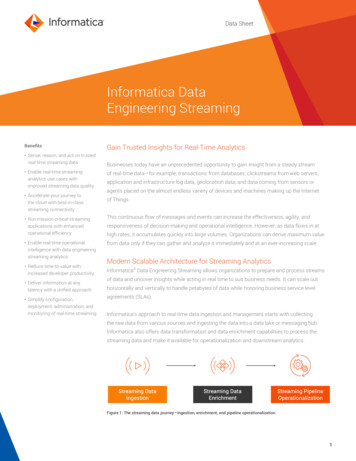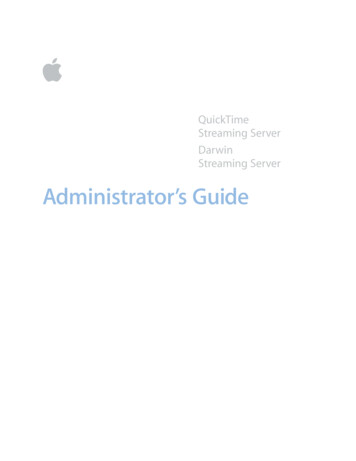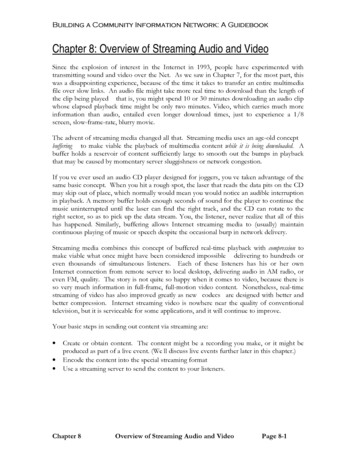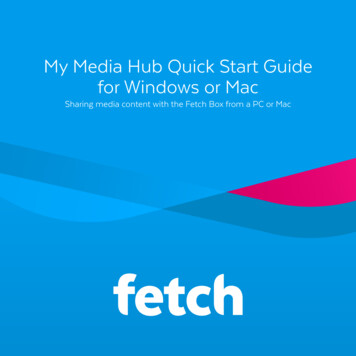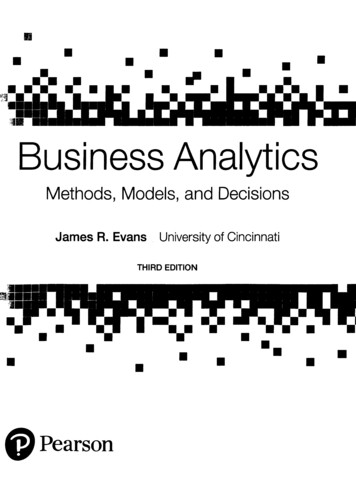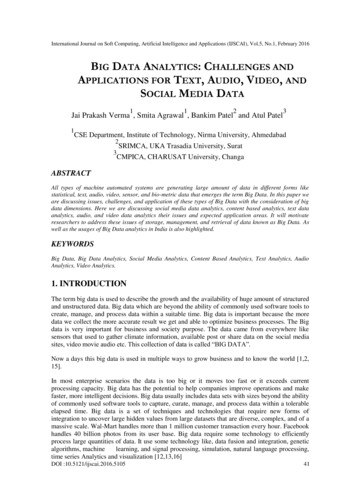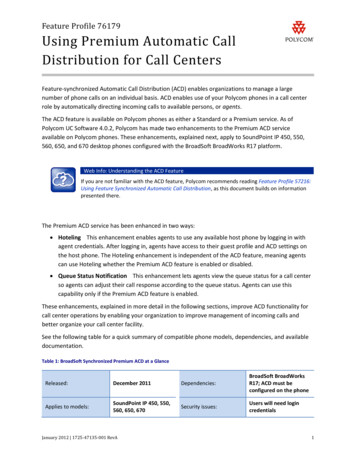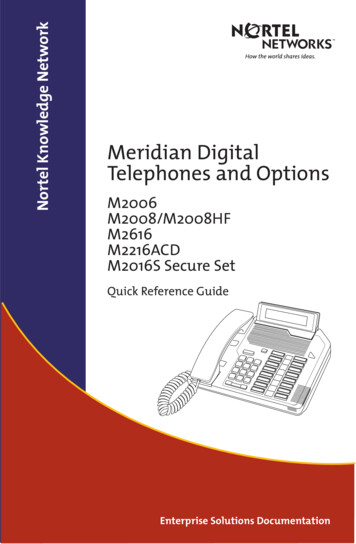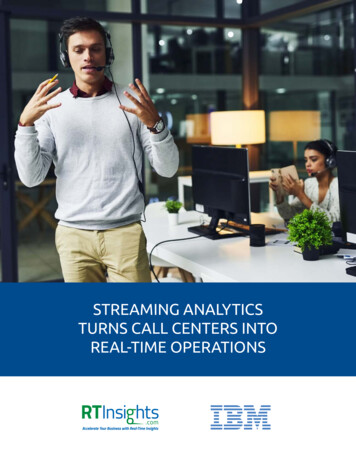
Transcription
STREAMING ANALYTICSTURNS CALL CENTERS INTOREAL-TIME OPERATIONS
TABLE OF CONTENTSChapter 1:Call Centers Step into the Analytics Stream. 3Chapter 2:Building the ‘Switchboard’ to a Streaming-Enabled Call Center . 5Chapter 3:Streaming Empowers a Major Telecom Provider’s High-Volume Call Centers . 7
Chapter 1:Call Centers Step into the Analytics StreamToday’s consumers demand experiences that are both instantaneous and personalized. Toprovide that level of service, call centers and customer service representatives (CSRs) must beable to quickly respond with information about the customer in question. Organizations havebeen collecting and storing relevant data about their customers for years, but many performanalysis only after a call. Though that approach has benefits, including improved agent trainingand websites, the optimal approach is to perform the analysis while the rep is interacting withthe customer.Add to that an increasing reliance on mobile and web applications that can serve every need.Why would consumers bother with a phone call when they can self-serve themselves out ofdozens of common problems with their troublesome product or service? The threat of highervolumes, longer waits, and more unsatisfied customers looms, but smart organizations aregetting ready for a big move into real-time analytics.This technology is making call centers relevant again.In the past, organizations relied almost exclusively on collecting vast quantities of data abouttheir customers, often in aggregate, to gather actionable insights. For example, a call centermight combine information about the nature of their customers’ calls, which would allowthem to understand not only which problems are the most common, but also which take themost time to resolve, along with which resolutions produce the highest (or lowest) customersatisfaction.These days, batch analytics systems include highly sophisticated andcomputationally intensive artificial intelligence (AI) and machine learning(ML) algorithms. These insights are often critical to an organization’sefforts to become more efficient and effective, but they don’t help a givencustomer during his or her interaction—they help only after the fact. Callcenter organizations have always desired ways to assist their customers inreal time, but the technology needed to enable that had been inaccessible.Call center organizationshave always desiredways to assist their customers in real time, butthe technology neededto enable that had beeninaccessible.Enter streaming analytics, which allows organizations to ingest and processaudio data during an ongoing call. The ability to perform speech-to-text conversion in real timecreates new opportunities to correlate the call’s context with an omnichannel view of thecustomer or apply AI/ML models in a matter of seconds.Let’s say a customer calls because she’s having trouble updating her smartphone’s operatingsystem. The speech-to-text conversion capability recognizes a few key words, such as “iPhone”and “update,” and immediately sends the CSR information about upgrade procedures andtroubleshooting. The speech data is also correlated with the customer’s account, which notifiesthe CSR that the customer is qualified for an upgraded phone. This empowers the rep to notonly help the customer with her current issue, but also upsell her on a new smartphone withthe update preinstalled.
Streaming Analytics at a Glance32% CAGR between 2018 and 2023 4 billion inglobal value in 2017Common uses: 22 billion inglobal value in 2023Ingestion of real-time social media sentimentPreventative maintenance on mission-critical equipmentAnalysis of a website visitor’s pathway to conversion or checkoutCybersecurity detection and preventionSource: Global Streaming Analytics Market – Growth, Trend and Forecasts (2018 - 2023), Research and Markets, July 2018Streaming analytics separates itself from batch analytics by time—namely, a focus on real-timeand instantaneous results. A combination of new technologies, faster computers, and moresophisticated data science has enabled this new generation of streaming analytics. Moresophisticated data lakes allow organizations to not only store more data than ever before, butalso to enable them to ingest, cleanse, prepare, and govern both structured and unstructureddata on easy-to-use cloud platforms. Quicker networks enable decentralized and non-siloeddata storage frameworks, and streaming analytics shortens the time gap between the collectionof raw data and the delivery of insights.In the past, organizations would need to invest in substantial infrastructure to access the powerof streaming analytics. Now that more analytics providers are offering streaming analytics in aSoftware-as-a-Service (SaaS) model, organizations can pay by the hour or by the month to ingesttheir data and gain actionable insights in real time.Modern call centers are enormously complex organizations, given the sheer number ofemployees, the volume of calls handled daily, and a constant drive to offer better service inless time. Call centers without streaming analytics capabilities struggle primarily with sentiment,complexity, and cost, which we’ll cover in the following chapter. Even organizations that haveimplemented the technology are looking for more practical insights that can be cross-referenced against other information they have about a given customer.With streaming analytics, organizations are beginning to ask: What if? What if we could analyzecustomer sentiment in real time based on speech-to-text analysis? What if we could calculatethe lifetime value of our customers? What if we could improve customer satisfaction, while alsoincreasing the productivity and morale of our employees? In the past, these opportunities mighthave been impossible, but this is the empowered era of streaming analytics.
Chapter 2:Building the ‘Switchboard’ to a Streaming-Enabled Call CenterWhen a customer dials a company’s support line, the experiencewith that vendor’s product is already less than ideal. A call center’s primary purpose is to mitigate that poor experience, offera resolution, and turn frustration into satisfaction. The last thingthe customer wants to do is explain the problem in great detail,but that’s precisely what a CSR needs to hear to figure out theproblem and offer a solution.Call centers are forced into a defensive mode from the momenta call begins, which is the first of many hurdles they need toclear. Without improvements in tooling and technology for callcenters and their employees, organizations continue to strugglewith sentiment, complexity, and cost.The Present: Batch Only and SiloedThe most challenging job a CSR faces—dozens of times per shift—is to be able to understandthe customer’s sentiment over the phone. Every CSR wants customers to end their call feelingsatisfied with the solution rather than annoyed or frustrated, but determining how to achievethat outcome is often left to guesswork.However, call centers can’t eliminate complexity and optimize their processes effectively ifthey don’t know how customers are feeling during any given moment of the experience—especially given that today’s consumers demand a “one-stop-shop” experience for resolvingtheir problems.The inability to understand sentiment and reduce complexity adds cost to each call. Everyminute of interaction is an expense, as is every hand-off between CSRs on different supporttiers. When employees can’t increase their productivity while handling calls and other duties,call center organizations are forced to spend more on payroll. When morale drops, HR mustspend more on onboarding, while also dealing with high turnover rates.All this adds up to an unsustainable, consumer-unfriendly business model.One critical issue is that a call center’s streaming analytics needs are different from most of anorganization’s other uses for streaming: A call center needs to process voice, text, and video;engage in social media sentiment analysis; and more—all in real time. Call centers have accessto a plethora of data about customers, but they often can’t access it fast enough or correlate itwith other critical information.
Pain Points of a Call CenterFor call centers to perform at their best, they need these capabilities:Scalability to withstand enormous, unexpected volumes of callsInstant response times to ensure customers receive potential solutions asquickly as possibleLow latency to move customers from problem to solution with little friction andwithout requiring hand-offs to other agents or support tiersSpeech-to-text technology to ensure that ongoing calls can be analyzed duringthe duration of the call, not after the factAI/cognitive capabilities that give call center operators the ability to understand sentiment and context in real timeAn omnichannel view of the customer that enables CSRs to understand notonly the current issue, but also the consumer’s entire experience with theorganization as a wholeThe Future: Real-Time and Comprehensive OperationsA streaming-enabled call center presents a very different picture. A customer’s first choice isoften to try out the self-service options, which are more effective due to analytics-based optimizations from the streaming service. If the customer still needs to contact the call center forpersonalized help, the CSR can answer the call with existing context regarding the problem.As the call continues, the streaming analytics platform can update the representative with newinsights by correlating the context of the request with other relevant information from theaccount, such as the customer’s last purchase, previous service requests, key demographics,and other data. A cognitive assistant personalizes these options for a given customer and offersthem to the CSR.The CSR can see an analysis of the customer’s sentiment at any given moment, helping to guideboth the advice they offer and how they offer it.But streaming analytics in the call center involves more than performing speech-to-text andanalyzing the ongoing conversation. Streaming enables call centers to identify repeat callersand categorize calls in real time, which also creates the ability to recognize patterns, such aswhere many customers are calling from or the topics many of them are interested in. Anincrease in calls from a specific region could signal a localized service outage, for example,which can effectively guide the CSR’s dialogue.
The Many Goals of an Optimized Call CenterReduce averagecall-handle timesIncrease customerretentionReduce agent-to-agenttransfersImprove employeeproductivityImprove first-contactresolutionsChapter 3:Streaming Empowers Telecom Provider’s High-Volume Call CentersA major mobile telecom provider with over 100 million customers (including millions of internetcustomers and TV subscribers) inevitably needs to deal with an immense volume of customerservice calls. In recent years, the company’s top personnel identified many opportunities toreduce complexity, understand sentiment, and reduce costs—but only if they could visualize theentire customer journey and receive insights in real time.The telecom provider wanted a call center experience thatwas cognitive, real time, and in context, with the end goalof raising first-call resolution rates by giving CSRs bettertools and new insights into the customer’s journey.“We need to better understand ourcustomers every step of the way. To provide a personalized experience,you need to understand the customerjourney, the customer intent, and gatherthe insights of the customer. Yoursystem should be intelligent, continuouslearning, and get smarter over time byunderstanding and correlatingcustomer interactions.”— Vice President of IT,Major Mobile Telecom Provider
A Closer Look: IBM Streaming System in ActionImagine a scenario in which a customer has just purchased a smartphone, brought it home,spent time configuring and customizing all the backgrounds and apps, only to discover that theemail doesn’t work. The moment of first fault is where the customer service experience begins:Any optimization that makes this process faster and friendlier for the customer saves money,improves engagement, and reduces the risk of churn.This telecom provider’s new streaming system begins during the call. Sophisticated naturallanguage processing capabilities on streaming data—for example, search queries for phrasessuch as, “I’ve just bought a cell phone and my email isn’t working”—allow the self-service systemto recognize key words and deliver the most popular and effective solutions. Intelligent recommendations can mitigate specific problems, but the company understands that it also needsmore effective call center operations.If the customer does need to phone customer service, call audio is transferred, in real time, intothe streaming analytics system as soon as the customer service representative picks up. IBMStreams performs speech-to-text analysis on that audio and correlates key phrases and overallsentiment with existing customer data to provide full context. This information is handed to theCSR immediately so he or she can react instantly and make appropriate recommendations. Thesystem is even capable of delivering a “curated” solution for the CSR to recommend.For example, let’s say the customer says he’s having an issue with the email on his new iPhone,but doesn’t specify which model. The Streams system would correlate the term “iPhone” withthe customer’s existing profile, which notes that he recently purchased an iPhone X. Becausesupport suggestions might differ from one model to the next, improving call center toolingenables the CSR to drive toward a solution in less time and with less hassle for the customer.Streams: More than ExpectedThe telecom provider’s primary purpose in implementing a streaming analytics solution wasto reduce first-call resolution rates, but it found that Streams’ capabilities were even morepowerful than expected. The company’s engineers have been able to write additionalapplications to solve ongoing problems and continue a pattern ofimprovement with call center operations.“Customers’ needs andMany of these newly built applications have incorporated IBM’sWatson technology for additional cognitive workloads. Theno-coding environment and open-source data science tools makethe development of these applications easier than any in-housesolution, and Watson’s AI capabilities can even be used to predictfuture trends based on the current state of streaming data.preferences are rapidly evolving.Customers expect a simple,personal, and reliable experiencethrough every interaction—whenever, wherever, howeverthey choose to interact with us.”— Vice President of IT,Major Mobile Telecom Provider
The business value for the company and its call centers:Improved first-call resolution ratesBetter call deflection, whereby the company reduces the volume of calls to the call centerby offering richer, more personalized self-service support optionsDecreased average call-handle timesA reduction in agent-to-agent transfers to create consistency and reduce labor costsData is merged from previously siloed data repositoriesCustomers spend less time in an interactive voice response (IVR) systemIn-depth contextual information improves revenue through cross-sell and upsell opportunitiesDelivering instantaneous and personalized experiences is no easy task, but using streaminganalytics as a foundation for smarter customer-centric analytics is ideal place to start. By providing the answers customers demand on a platform that works for them—with minimal timeand effort—call center organizations can empower their CSRs with potent tools to improvethe customer experience, enhance employee productivity, and significantly increase customerretention and company revenue.For more information on IBM Streams, visit https://www.ibm.com/cloud/streaming-analytics
RTInsights is an independent, expert-driven web resource for senior business and IT enterpriseprofessionals in vertical industries. We help our readers understand how they can transformtheir businesses to higher-value outcomes and new business models with IoT real-time analytics.We provide clarity and direction amid the often confusing array of approaches and vendor solutions. We provide our partners with a unique combination of services and deep domain expertise to improve their product marketing, lead generation, and thought leadership activity.IBM Streams analyzes the broadest range of streaming data, making decisions while eventsare happening. It brings meaning to fast-moving data streams and helps organizations in a widevariety of industries. Now organizations can subscribe to device data to provide advanced analytics using Streams with IoT platform capabilities.A key component of the IBM Cloud Platform, Streams offers a computing platform that helpsorganizations turn burgeoning, fast-moving volumes and varieties of data into insight. It deliversa programming language and an integrated development environment (IDE) for applications, aruntime system that executes the applications on a single host or a distributed set of hosts, andanalytic toolkits to help speed development. You can use Java and Python to develop applications for deployment to the runtime. Streams can ingest, filter, analyze, and correlate massivevolumes of continuous data streams.These data streams can originate from any of the following:· IoT devices and sensors.· Text files, spreadsheets, images, video, and audio recordings.· Email, chat, and instant messaging; web traffic, blogs, and social networking sites.· Financial transactions, customer service records, telephone usage records, and system andapplication logs.· Satellite data, GPS data, smart devices, sensors, network traffic, and messages.
call center organizations are forced to spend more on payroll. When morale drops, HR must spend more on onboarding, while also dealing with high turnover rates. All this adds up to an unsustainable, consumer-unfriendly business model. One critical issue is that a call center's streaming analytics needs are diferent from most of an
